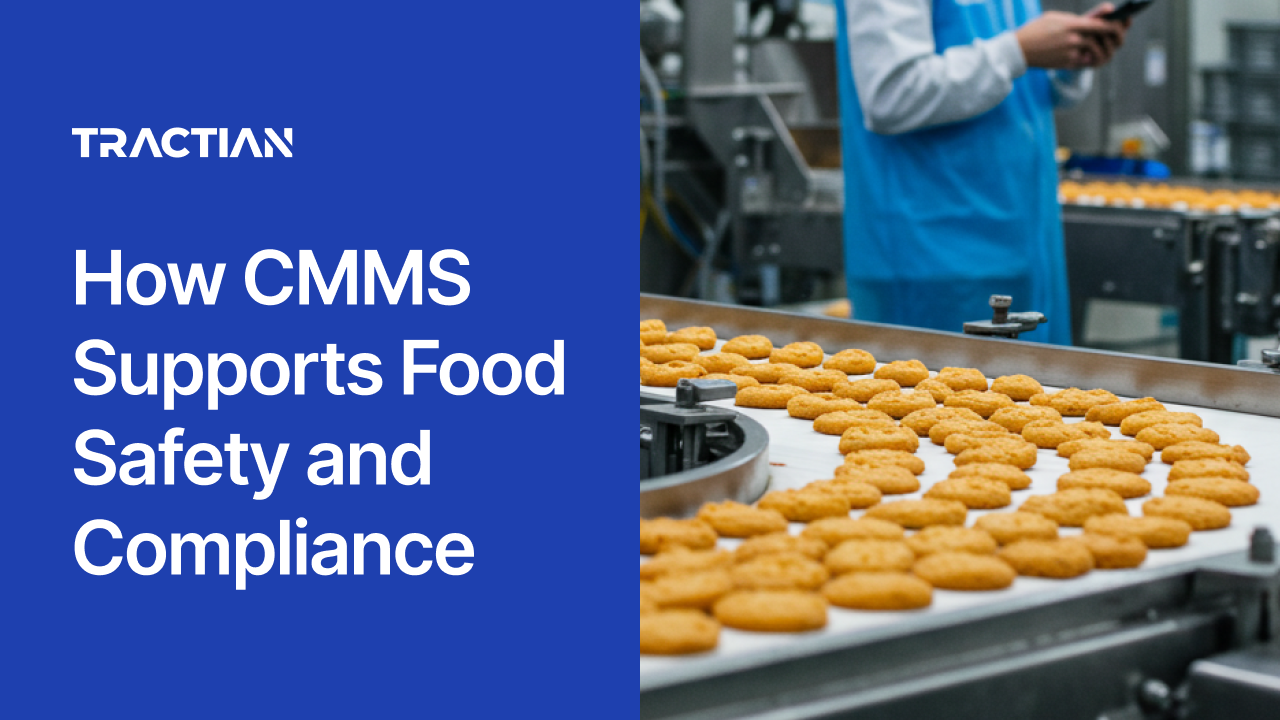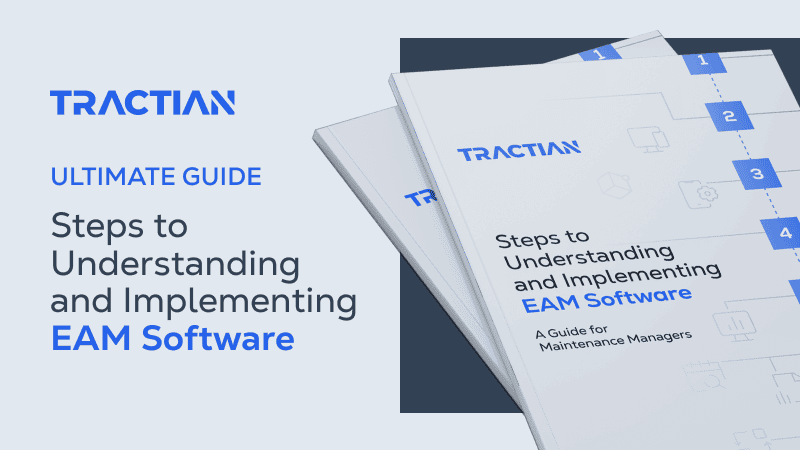In food and beverage manufacturing, safety and compliance lay the groundwork for successful operations. With pressure from regulatory bodies and strict audit requirements to contend with, maintenance teams can’t afford any loose ends.
A CMMS makes a huge difference here by providing structure, visibility, and repeatability across the plant floor. It also helps with asset management and inventory control.
Whether it’s tracking work orders tied to sanitation procedures or ensuring equipment inspections follow strict intervals, a CMMS system creates a documented, auditable flow of activity.
And most importantly, it eliminates blind spots, so maintenance becomes predictable and standardized.
In this article, we’ll explain how CMMS helps industrial teams ensure food safety, meet compliance demands, and create a maintenance routine built for inspection.
What is CMMS
A CMMS (Computerized Maintenance Management System) is the backbone of any structured maintenance program. It’s the system responsible for coordinating every maintenance task across a facility.
Instead of chasing work orders on paper or losing time with disconnected spreadsheets, teams use the CMMS to handle everything maintenance-related from one system.
This means everything that happens on the floor, like cleaning cycles or corrective actions, gets documented and time-stamped.
In regulated industries like food and beverage, where a missed step can become a recall risk, that level of control isn’t optional. A CMMS enforces standardization, building the traceability needed to face audits with confidence.
The Role of Maintenance in Food Safety Practices
In a food processing plant, maintenance is directly tied to product integrity. Even something as small as a worn seal on a pump creates contamination risks that routine QA checks won’t catch in time.
That’s why maintenance procedures are embedded in every food safety plan. Whether it’s HACCP, FSMA, or GFSI-based standards, regulatory frameworks require documented maintenance routines for equipment that comes into direct or indirect contact with the product.
And it goes deeper. Preventive maintenance isn’t just recommended, it’s required. Teams must prove that assets are inspected, cleaned, and serviced at proper intervals. Any gap becomes a compliance liability, especially during audits or inspections.
Benefits of CMMS for Food Manufacturing
For food manufacturers, a CMMS supports everything from regulatory compliance to production efficiency. The benefits reach far beyond the maintenance team too, and ultimately affect profitability.
Here’s a closer look at how a CMMS helps food and beverage operations gain control over their entire maintenance routine.
Ensure Compliance with Food Safety Regulations
A CMMS enforces traceability by first timestamping every maintenance action and then linking it to the asset, technician, and task type. When regulators request evidence, the data is already there.
This is critical for passing audits tied to FDA regulations, FSMA requirements, or GFSI standards like SQF and BRC. Many of these frameworks require documented proof that preventive actions were carried out at defined intervals using validated procedures.
A CMMS like Tractian's automates preventive schedules, ensuring records are always ready for regulatory review.
Reduce Food Waste
Equipment failures in food processing don’t just mean downtime, they often mean entire product lots are scrapped. A CMMS helps avoid situations like these by making sure critical assets stay within performance thresholds.
For example, a failed heat exchanger in a pasteurization line can render thousands of gallons of product unsafe.
But with asset histories and real-time task execution tracked in the system, maintenance teams can intervene early. CMMS tools also enable root cause tracking, so recurring issues are addressed at the source.
Maximize Equipment Reliability
Reliability in food production is tied to strict scheduling. There’s no room for last-minute repairs when lines run 24/7 or operate in tight windows.
A CMMS lets teams monitor work completion rates and flag underperforming assets based on actual conditions.
This directly affects reliability metrics like MTBF (Mean Time Between Failures) and downtime frequency. When work orders are visible to everyone, reactive maintenance becomes the exception, not the norm.
And that shift has a ripple effect across safety, cost, and throughput.

Make Smarter Asset Management Decisions
Food manufacturing environments deal with a wide range of assets, and each comes with its own set of unique requirements.
With a CMMS, teams gather valuable maintenance data that can be used to inform replacement planning, CAPEX requests, and service contract negotiations.
Instead of guessing when a machine is nearing the end of its lifecycle, you have the data to prove it.
Real-time Inventory Management
In food production, delayed maintenance due to missing parts can halt a batch mid-process. A CMMS with integrated inventory control prevents those setbacks by tracking part usage in real time.
Technicians can see exactly what’s available before starting a task, and planners can identify fast-moving items or critical spares tied to high-risk assets.
Documentation and Compliance
A CMMS captures detailed logs for every maintenance task, including who performed it, what was done, and when it was completed. That record supports compliance by providing detailed, time-stamped documentation that auditors can verify during inspections.
Whatever you're preparing for, that level of traceability changes the game. It eliminates the scramble for paperwork and builds trust that your process meets regulatory and safety expectations.
Streamlined Production Processes
A CMMS aligns maintenance and production by integrating maintenance schedules with production calendars, ensuring tasks are completed during changeovers, shutdowns, or low-demand windows.
This results in fewer unplanned interruptions and better coordination across departments. By linking maintenance to operational goals, the CMMS becomes a tool for production reliability, not just equipment upkeep.
Modernize Your Maintenance Operations
A modern CMMS shifts your team from reactive firefighting to proactive control at every level.
Technicians get mobile access to work orders, procedures, and asset histories. Managers gain real-time dashboards showing task completion rates. And leadership sees how maintenance ties directly into and production goals.
Food Traceability and Its Role in Food Safety Compliance
When problems arise in food production, traceability is essential.T
Traceability isn't limited to ingredients or production stages, though, equipment maintenance plays a critical role. Every action on machinery that contacts food must be documented.
A CMMS complements traceability efforts by logging equipment interventions that can be cross-referenced with production records during incident reviews.
Each task is stored with detailed information alongside operational records. This enables teams to quickly determine if any maintenance activities correlate with a deviation.
Besides that, a CMMS provides regulators and auditors with documented evidence that equipment conditions were controlled and no steps were overlooked.
CMMS and HACCP Compliance
HACCP (Hazard Analysis and Critical Control Points) is one of the most established systems in global food safety. It requires manufacturers to identify potential hazards, define control points, and prove that risks are consistently managed.
And while it’s often seen as a quality assurance function, maintenance makes sure those controls are kept intact.
Things like delayed inspections can compromise critical control points (CCPs). A CMMS brings visibility to those maintenance routines, so they’re carried out on time and in alignment with the facility’s HACCP plan.
For example, if a metal detector is listed as a CCP, its reliability depends on scheduled calibration, documented testing, and rapid repair when faults occur.
With a CMMS, each of those actions is scheduled automatically and stored in a format ready for verification, whether by QA teams or regulators.
The system also helps identify failure patterns across equipment tied to food safety risks.
If a sealing unit on a packaging line frequently fails, or if sanitation checks are consistently overdue on a specific asset, the CMMS highlights those issues before they escalate into full deviations.
Understanding SQF and BRCGS Certifications
SQF and BRCGS are among the most widely adopted food safety certification programs globally. Both are built around the same principle: preventing food safety risks before they happen.
And that includes risks introduced through poorly maintained or unverified equipment.
Under the SQF Code, equipment must be maintained in good condition, cleaned correctly after use, and kept covered or protected when not in operation.
If a tool or component breaks, teams must immediately report and repair it to avoid contamination or unsafe conditions.
BRCGS, through its Global Standard for Food Safety, reinforces the same expectations. It requires a preventive maintenance plan or condition monitoring system that includes all processing and mobile equipment.
It also emphasizes clear maintenance procedures from the moment new assets are commissioned, ongoing documentation of inspection results, and evidence that all corrective actions have been implemented appropriately.
Both frameworks prioritize auditable processes.
Maintenance activity must be documented and made accessible for inspections. With aCMMS, very action is traceable across audits.
Tips for Passing an SQF or BRCGS Audit
Passing a food safety audit is about proving that your processes are under control every single day. Auditors aren’t just looking for paperwork, they’re evaluating how well systems are implementedacross youroperation.
For maintenance teams, that means more than a clean workshop or completed work orders. It means having a structured process that can be demonstrated in real time.
Here’s what matters most:
1. Document Everything
Auditors will want to see clear records. Every intervention tied to food-contact or critical equipment must be traceable, with timestamps, technician names, and attached procedures.
A CMMS ensures this data is complete, accessible, and audit-ready.
2. Link Maintenance to Risk
Both SQF and BRCGS emphasize risk-based thinking. That means showing how you prioritize maintenance activities based on the impact of asset failure.
Define which assets are critical, explain how their PM schedules are built, and use historical failure data to back it up.
3. Validate Your Procedures
It’s not enough to have a checklist. Maintenance procedures, especially those involving cleaning, lubrication, or component replacement, must be validated to show they’re up to standard.
Auditors may ask when the procedure was last reviewed or why a certain frequency was chosen.
4. Be Ready to Prove Training
Technicians must be qualified to perform tasks that could impact food safety. Keep training records updated and linked to user profiles in your CMMS. If someone closes out a work order, you need to show they were trained to handle that task.
5. Review Your Preventive Maintenance Completion Rates
Low PM completion rates or high numbers of deferred tasks raise red flags. Before the audit, run reports to identify gaps and investigate overdue work. Address any recurring delays or resource constraints and document the actions taken to bring your schedule back into control.
6. Test Your System Before the Audit
Simulate a traceability request. Can you pull up the last five maintenance tasks on a critical asset? Can you show when it was cleaned, who did the work, and which SOP was followed?
This kind of pre-audit drill identifies weak points and gives you a chance to close gaps before the auditor finds them.
How Tractian’s CMMS Strengthens Food Safety and Compliance
Food manufacturers are under more pressure than ever to deliver without sacrificing speed or efficiency.
And for teams responsible for keeping assets running and standards in check, that pressure shows up every day.
Tractian’s CMMS gives maintenance teams full control, all within a single system. Tasks are planned based on asset risk, scheduled with precision, and tracked in real time with built-in traceability.
Beyond compliance, Tractian’s CMMS is built for scale and speed. Onboarding is designed to be comprehensive without disrupting daily operations. Once in place, every process becomes documented and repeatable, standardizing execution across shifts and sites.
Combined with advanced analytics and automated reporting, it makes fully data-driven maintenance possible.
When an audit hits or a deviation needs investigation, everything’s ready to go.



